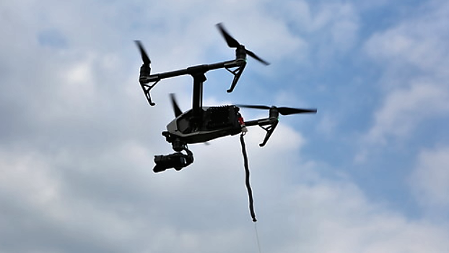CHARLOTTE, N.C.—Fox Sports added a tethered drone to its lineup of production tech innovations to cover the Great American Race, the Daytona 500, from the Daytona International Speedway, Sunday, Feb. 18, on the Fox broadcast network.

Tethered along the backstretch of the speedway, the drone delivered live coverage as it hovered and moved around outside the racing area to deliver new angles on the race. Tethering the drone allowed the broadcaster to extend flight times by eliminating the need to change batteries.
“Each year, Daytona Speedweeks allows us to develop, test and deploy more and more technical enhancements than we are able to do at most other events,” said Michael Davies, Fox Sports SVP Field & Technical Operations.
Other enhancements for this year’s race included Fox Sports’ Visor Cam—a Daytona 500 first that’s a small camera clipped to the helmets of two drivers, Kurt Busch and Daniel Suarez; the first fiber NASCAR IP transmission; a variety of stabilized mounts for pit coverage; and a digital mosaic, he added.
[Fox Sports Enhances POV, Super Mo Tech for NFL Playoffs]
The sports broadcaster relied on a record 14 in-car cameras, including one in the Daytona 500 pace car, which is more than any NASCAR race in the past 15 years, according to Fox. Fox Sports Go delivered an immersive compilation stream of multiple in-car cameras with live telemetry and the Fox Sports streaming app also showed the linear broadcast.
Another bit of production sizzle was delivered via the broadcaster’s touchscreen 3D cutaway car that analyst Larry McReynolds used to give viewers clear explanations of changes to cars. Virtual leaderboards, sponsor enhancements and race summaries displayed on virtual billboards in Turn 3 were created with a combination of camera-tracking technology from Stype and Vizrt 3D graphics.
The professional video industry's #1 source for news, trends and product and tech information. Sign up below.
The production utilized 300 Fox Sports personnel, seven main mobile production units located in the multi-network TV compound at the speedway, a pair of satellite uplinks and mobile generators to deliver 2MW of power separate from local power.
Besides the drone, the production tech included 20 manned cameras, three in-track Gopher Cams, two 6x Sony 4300 super slow motion cameras, one 16x Sony 4800 super slow motion camera, RF cameras and audio from BSI and telemetry and graphics from SMT.
Phil Kurz is a contributing editor to TV Tech. He has written about TV and video technology for more than 30 years and served as editor of three leading industry magazines. He earned a Bachelor of Journalism and a Master’s Degree in Journalism from the University of Missouri-Columbia School of Journalism.

